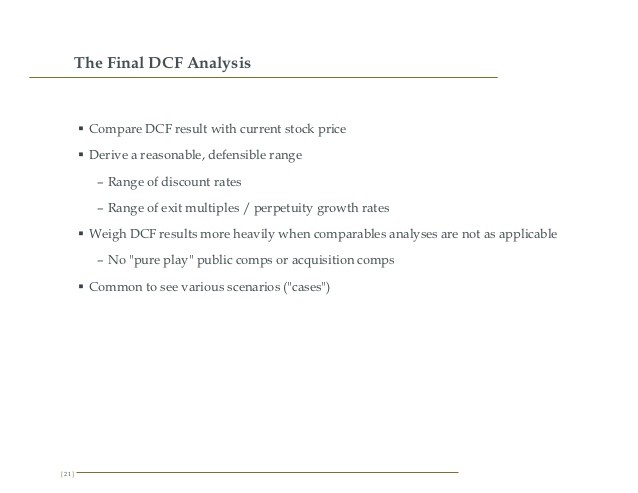Taking Stock Of Discounted Cash Flow
Post on: 15 Август, 2015 No Comment

At a time when financial statements are under close scrutiny, the choice of what metric to use for making company valuations has become increasingly important. Wall Street analysts are emphasizing cash flow-based analysis for making judgments about company performance.
A key valuation tool at analysts’ disposal is discounted cash flow (DCF) analysis. Analysts use DCF to determine a company’s current value according to its estimated future cash flows.
Forecasted free cash flows (operating profit + depreciation + amortization of goodwill — capital expenditures — cash taxes — change in working capital ) are discounted to a present value using the company’s weighted average costs of capital. For investors keen on gaining insights on what drives share value, few tools can rival DCF analysis.
Recent accounting scandals and inappropriate calculation of revenues and capital expenses give DCF new importance. With heightened concerns over the quality of earnings and reliability of standard valuation metrics like P/E ratios. more investors are turning to free cash flow, which offers a more transparent metric for gauging performance than earnings. It is harder to fool the cash register. Developing a DCF model demands a lot more work than simply dividing the share price by earnings or sales. But in return for the effort, investors get a good picture of the key drivers of share value: expected growth in operating earnings, capital efficiency, balance sheet capital structure, cost of equity and debt, and expected duration of growth. An added bonus is that DCF is less likely to be manipulated by aggressive accounting practices.
DCF analysis shows that changes in long-term growth rates have the greatest impact on share valuation. Interest rate changes also make a big difference. Consider the numbers generated by a DCF model offered by Bloomberg Financial Markets. Sun Microsystems, which recently traded on the market at $3.25, is valued at almost $5.50, which makes its price of $3.25 a steal. The model assumes a long-term growth rate of 13.0%. If we cut the growth rate assumption by 25%, Sun’s share valuation falls to $3.20. If we raise the growth rate variable by 25%, the shares go up to $7.50. Similarly, raising interest rates by one percentage point pushes the share value to $3.55; a one percent fall in interest rates boosts the value to about $7.70.
Investors can also use the DCF model as a reality check. Instead of trying to come up with a target share price, they can plug in the current share price and, working backwards, calculate how fast the company would need to grow to justify the valuation. The lower the implied growth rate, the better — less growth has therefore already been priced into the stock.
Best of all, unlike comparative metrics like P/Es and price-to-sales ratios, DCF produces a bona fide stock value. Because it does not weigh all the inputs included in a DCF model, ratio-based valuation acts more like a beauty contest: stocks are compared to each other rather than judged on intrinsic value. If the companies used as comparisons are all over-priced, the investor can end up holding a stock with a share price ready for a fall. A well-designed DCF model should, by contrast, keep investors out of stocks that look cheap only against expensive peers.

DCF models are powerful, but they do have shortcomings. DCF is merely a mechanical valuation tool, which makes it subject to the axiom garbage in, garbage out. Small changes in inputs can result in large changes in the value of a company. Investors must constantly second-guess valuations; the inputs that produce these valuations are always changing and susceptible to error.
Meaningful valuations depend on the user’s ability to make solid cash flow projections. While forecasting cash flows more than a few years into the future is difficult, crafting results into eternity (which is a necessary input) is near impossible. A single, unexpected event can immediately make a DCF model obsolete. By guessing at what a decade of cash flow is worth today, most analysts limit their outlook to 10 years. Investors should watch out for DCF models that are taken to ridiculous lengths. Samantha Gleave, a London-based analyst with Credit Suisse First Boston, published a DCF model for Eurotunnel that runs through 2085!
These are not the only problems. With its focus on long-range investing, the DCF model isn’t suited for short-term investments. A model that shows that Sun Microsystems is worth $5.50 does not mean that it will trade for that any time soon; furthermore, over-reliance on DCF can cause investors to overlook unusual opportunities. DCF can prevent investors from buying into a market bubble. DCF can also prompt investors to sell, which might mean they miss those big share price run-ups that can be so profitable (provided the shares are sold at the peak).
Don’t base your decision to buy a stock solely on discounted cash flow analysis. It is a moving target, full of challenges. If the company fails to meet financial performance expectations, if one of its big customers jumps to a competitor, or if interest rates take an unexpected turn, the model’s numbers have to be re-run. Any time expectations change, the DCF-generated value is going to change.














